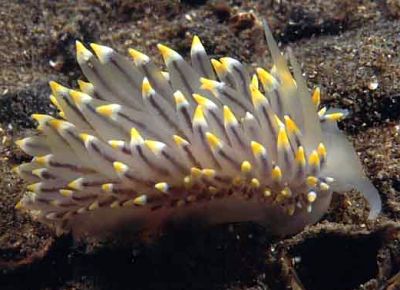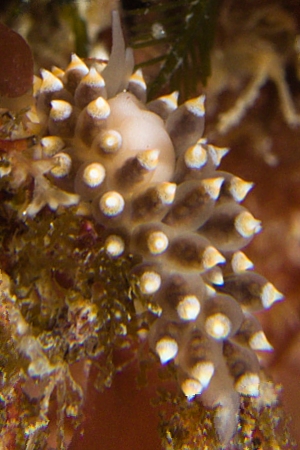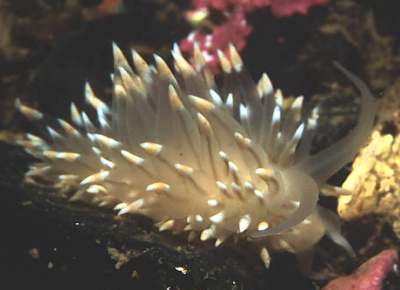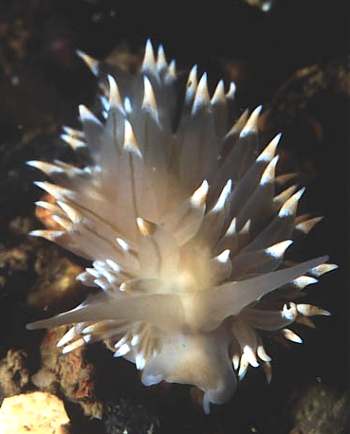
Eubranchus tricolor
Forbes, 1838
Order: NUDIBRANCHIA
Suborder: AEOLIDINA
Family: Eubranchidae
DISTRIBUTION
Northeastern Atlantic from Arctic to Atlantic coast of France [including British Isles].
PHOTO
Dunollie Point, Oban on the west coast of Scotland. March 2000. 26 metres on a sponge. Approximately 24 mm long. Photo: Jim Anderson
Grows to approximately 45 mm. The body is a pale translucent yellow or greyish white. The inflated cerata but are packed closely together rather than arranged in rows. The cerata are translucent whitish with an opaque white cap at the tip. On the white is a golden yellow subterminal ring. Each ceras has a dark digestive gland duct. Thompson (1988) notes that juveniles up to 13 mm in length may be white all over, except for the pale brown core to each ceras. It has been recorded from a number of both calyptoblastic and gymnoblastic hydroids, but most characteristically it is found on delicate calyptoblasts such as Obelia geniculata.
Reference:
• Thompson, T.E. (1988) Molluscs: Benthic Opisthobranchs (Mollusca: Gastropoda). Synopses of the British Fauna (New Series). No. 8. 2nd Edition. E.J.Brill/W. Backhuys: Leiden. 1-356.
Rudman, W.B., 2001 (December 3) Eubranchus tricolor Forbes, 1838. [In] Sea Slug Forum. Australian Museum, Sydney. Available from http://www.seaslugforum.net/find/eubrtric
Related messages
Eubranchus tricolor - strange form
April 15, 2006
From: Jim Anderson

Dear Bill,
The animal was ID'd for me by Bernard Picton who commented,
"I've seen individuals with this bare back and extra swollen cerata on Tubularia, I suspect that getting stung by the Tubularia induces this atypical appearance, but I could be wrong and they could be a different species altogether. No way to tell, except DNA I guess."
Locality: Bogha Na Fionn-Aird, Island of Muck, 12 m, Scotland, Atlantic Ocean, 9 April 2006, vertical rocky reef. Length: 15 mm. Photographer: Jim Anderson.
Kind regards,
Jim A
jander4454@gmail.com
Anderson, J., 2006 (Apr 15) Eubranchus tricolor - strange form. [Message in] Sea Slug Forum. Australian Museum, Sydney. Available from http://www.seaslugforum.net/find/16321Dear Jim,
The pericardial region [over the heart] does seem very swollen. Perhaps they have a parasite in their?
Best wishes,
Bill Rudman
Eubranchus tricolor from Eastport, Maine
August 26, 2003
From: Alan Shepard


Bill -
Here are a couple of shots of what I believe is Eubranchus tricolor from Eastport, Maine, USA. I had been told to look for this species in approximately 15 meters of water and that is almost precisely where I encountered it. I encountered two other specimens in a two-week period of diving all at approximately the same depth.
This individual was approximately 25mm long and was crawling along a gravel bottom with sparse patches of hydroids here and there. The dive site is noted for strong currents due to the extreme tidal activity in the Bay of Fundy area.
During the dive trip I found numerous other species that I will be sending photos of shortly.
Sincerely,
Alan Shepard
Tolland, CT, USA
alan.chepard@snet.net
Shepard, A., 2003 (Aug 26) Eubranchus tricolor from Eastport, Maine. [Message in] Sea Slug Forum. Australian Museum, Sydney. Available from http://www.seaslugforum.net/find/10801Thanks Alan,
It certainly looks like Eubranchus tricolor to me. I look forward to the other photos from your dive trip. It is nice to get photos of this east coast Nth American fauna
Best wishes,
Bill Rudman
Eubranchus tricolor from Scotland
December 8, 2001
From: Jim Anderson

Dear Dr. Rudman,
Here is Eubranchus tricolor, another Scottish nudibranch.
March 2000. Dunollie Point, Oban on the west coast. This solitary animal was found at 26 metres on a sponge. It is approximately 24 mm long.
Kind regards,
Jim A
jander4454@aol.com
Anderson, J., 2001 (Dec 8) Eubranchus tricolor from Scotland. [Message in] Sea Slug Forum. Australian Museum, Sydney. Available from http://www.seaslugforum.net/find/5747Thanks Jim,
Bill Rudman
